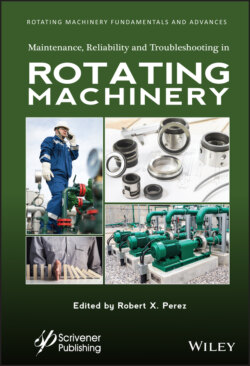Читать книгу Maintenance, Reliability and Troubleshooting in Rotating Machinery - Группа авторов - Страница 36
Additional Reliability Assessment Tools for Spared Machines
ОглавлениеUseful reliability analysis tools take the available historical failure data and transforms them into either visual or concise tabular results. These visual displays can identify reliability problems that require our attention. Here are some of the types of reliability analysis tools we will cover and/or review:
Pareto failure plots (for more information, see Pareto Charts & 80-20 Rule insert below).
Bad actor forced rankings
Reliability growth plots
MTBF trends
Let’s start by reviewing a simple tool that looks at failures on a sitewide basis. Table 2.1 contains a forced ranking of pump failures for various processing units across a site. By listing the mean time between repairs (MTBF) over the last 12 months, we can quickly identify the potential areas that may need addressing. In the case shown here, the Cat Cracking area seems to be the most problematic of all.
The pump failure data from Table 2.1 can also be converted into a Pareto chart to provide a summary of pump reliability at a glance (Figure 2.4). (A Pareto chart, seen in Figure 2.4, is a bar graph display of the frequency that events or measurements appear in a data group of interest.) In our Pareto chart example, pump failure frequencies over the last 12 months for various processing areas are plotted in order of decreasing failure frequency from left to right. Pareto charts are extremely useful for identifying issues that should be addressed first. The reader can quickly see that the Catalytic Cracking area had the most pump repairs over the last 12 months, and that the South Terminal area had the fewest repairs over the same time period. The visual results from this Pareto chart suggest that more study of the catalytic cracker pump failures is warranted.
Table 2.1 A hypothetical table of pump failures across a processing facility.
| Number of pump trains | Number of repairs last year | Total repair cost, $ | MTBF (Months) | |
| Catalytic Cracker | 50 | 34 | 272000 | 17.65 |
| Coker Unit | 42 | 21 | 168000 | 24 |
| Crude Unit | 40 | 15 | 120000 | 32 |
| Alky Unit | 35 | 15 | 120000 | 28 |
| Fractionation Unit | 40 | 15 | 120000 | 32 |
| Sulfur Unit | 25 | 15 | 120000 | 20 |
| Utilities | 42 | 12 | 96000 | 42 |
| Hydrotreating | 32 | 12 | 96000 | 32 |
| North Terminal | 30 | 8 | 64000 | 45 |
| South Terminal | 32 | 8 | 64000 | 48 |
Figure 2.4 Pareto chart of total pump failures over the last 12 months for various processing units. The “cumulative percentage” line helps in determining how various groups add to the total failure population. For example, the Cat Cracker and Coker Unit failures represent about 35% of total plantwide pump failures.
Table 2.2 A forced ranking of pump failures in a hypothetical cat cracking unit.
| Pump | Failures in last 12 months | Total repair costs for the last 12 months |
| 31-P-09 A&B | 5 | $ 50,000 |
| 31-P-05 A&B | 4 | $ 40,000 |
| 31-P-04 A&B | 3 | $ 30,000 |
| 31-P-08 A&B | 3 | $ 30,000 |
| 31-P-17 A&B | 3 | $ 30,000 |
| 31-P-25 A&B | 3 | $ 30,000 |
| 31-P-02 A&B | 2 | $ 20,000 |
| 31-P-06 A&B | 2 | $ 20,000 |
| 31-P-10 A&B | 2 | $ 20,000 |
| 31-P-11 A&B | 2 | $ 20,000 |
| 31-P-12 A&B | 2 | $ 20,000 |
| 31-P-14 A&B | 2 | $ 20,000 |
| 31-P-16 A&B | 2 | $ 20,000 |
| 31-P-18 A&B | 2 | $ 20,000 |
| 31-P-19 A&B | 2 | $ 20,000 |
| 31-P-22 A&B | 2 | $ 20,000 |
| 31-P-23 A&B | 2 | $ 20,000 |
| 31-P-01 A&B | 1 | $ 10,000 |
| 31-P-03 A&B | 1 | $ 10,000 |
| 31-P-07 A&B | 1 | $ 10,000 |
| 31-P-13 A&B | 1 | $ 10,000 |
| 31-P-20 A&B | 1 | $ 10,000 |
| 31-P-21 A&B | 1 | $ 10,000 |
| 31-P-24 A&B | 1 | $ 10,000 |
| 31-P-15 A&B | 0 | $ - |
Now that we know most of the pump failures occurred in the Cat Cracking unit, we can narrow our focus to those pumps. Table 2.2 shows a forced ranking of the pumps with the most failures. In our hypothetical case, Pumps 31-P-09 A&B failed five times in the last 12 months. Assuming that each repair costs about $10,000, we now see that the worst actor cost us about $50,000 in the last 12 months.
You may choose to label the least reliable pumps at your site as “bad actors.” Bad actors typically make up 7% to 10% of the pumps at your site that cost the most to maintain and cause you the most headaches. It makes sense to aggressively address bad actors first.
